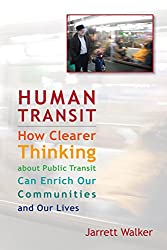
Rating: 8.3/10.
Book about city planning, specifically designing for public transit. Public transit is any form of transport that has a fixed schedule and is open to the public. Although public transit is familiar to all of us, there are still many non-obvious design considerations, and often there are tradeoffs where you cannot satisfy all the competing goals, so the transit planner needs to have a conversation with stakeholders about what goals are important.
Frequency is the most important factor, since it gives riders the freedom to travel when they want, instead of scheduling their lives around transit. The speed of the vehicle is relatively less important. Thus it’s detrimental to run more lines than necessary, since it will lead to lower frequency and longer wait times. Frequency may be higher during peak hours, but this creates issues for driver scheduling.
Transit is most successful in high-density areas, so if your goal is maximizing ridership, it’s best to concentrate your efforts on these areas. On the other hand, some systems want to maximize coverage (delivering some level of service to a large area), for people that cannot drive. Ridership falls dramatically if the distance to a stop is more than 400m (5 minute walk), so there’s another tradeoff between more stops vs fewer stops (faster speed but less coverage).
The most direct and efficient route is a straight line, and everyone hates detours (eg: into a cul-de-sac and back out). It’s good to design the system such that many places are “on the way” to other destinations, minimizing detours, but achieving this requires thinking about transit early in the city planning process.
There’s a lot of considerations and tradeoffs to make when designing transit for a city, so it’s best to plan for the long term (20-year time horizon) rather than react to immediate problems. Unfortunately, high-density city planning that are optimal for public transit seems to direct conflict with the needs of private cars, so the solution is probably to have some of both and let people choose where they prefer to live.



